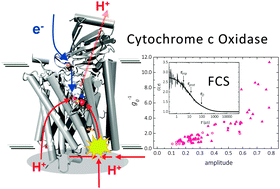A simulation-guided fluorescence correlation spectroscopy tool to investigate the protonation dynamics of cytochrome c oxidase†
Abstract
Fluorescence correlation spectroscopy (FCS) is a single molecule based technique to temporally resolve rate-dependent processes by correlating the fluorescence fluctuations of individual molecules traversing through a confocal volume. In addition, chemical processes like protonation or intersystem crossing can be monitored in the sub-microsecond range. FCS thereby provides an excellent tool for investigations of protonation dynamics in proton pumps like cytochrome c oxidase (CcO). To achieve this, the pH-dependent fluorescent dye fluorescein was attached as a protonation probe to the CcO surface via site-specific labeling of single reactive cysteines that are located close to the entry point of a proton input channel (K-pathway). The analysis of protonation dynamics is complicated by overlapping triplet and protonation rates of the fluorophore. A Monte Carlo simulation based algorithm was developed to facilitate discrimination of these temporally overlapping processes thus allowing for improved protonation reaction rate determination. Using this simulation-guided approach we determined precise local proton association and dissociation rates and provide information about protein surface effects, such as proton collecting antennae, on the transport properties of proton transfer channels.


 Please wait while we load your content...
Please wait while we load your content...